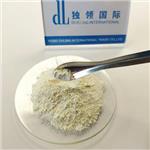- QUINOXYFEN
-

- $50.00 / 1kg
-
2023-03-24
- CAS:124495-18-7
- Min. Order: 1kg
- Purity: 98%
- Supply Ability: 20 tons
|
| | QUINOXYFEN Basic information |
| | QUINOXYFEN Chemical Properties |
| Melting point | 105-106° | | Boiling point | 423℃ | | density | 1.430 | | vapor pressure | 1.2 x 10-5 Pa (20 °C) | | Fp | >100 °C | | storage temp. | 0-6°C | | solubility | Chloroform (Slightly), Methanol (Slightly) | | Water Solubility | 0.12 mg l-1 (20 °C) | | pka | 2.87±0.50(Predicted) | | color | White to Light yellow | | Merck | 14,8079 | | LogP | 5.1 at 20℃ | | Dissociation constant | 3.56 | | EPA Substance Registry System | Quinoxyfen (124495-18-7) |
| Hazard Codes | Xi,N | | Risk Statements | 43-50/53 | | Safety Statements | 24-37-46-60-61 | | RIDADR | UN3077 9/PG 3 | | WGK Germany | 3 | | RTECS | VB4287500 | | HazardClass | 9 | | PackingGroup | III | | HS Code | 38220090 | | Hazardous Substances Data | 124495-18-7(Hazardous Substances Data) | | Toxicity | LD50 orally in rats: >5000 mg/kg; dermally in rabbits: >2000 mg/kg; by inhalation in rats: >3.38 mg/l (Longhurst) |
| | QUINOXYFEN Usage And Synthesis |
| Chemical Properties | Off-White Solid | | Uses | Quinoxyfen is under development for the control of powdery
mildew in cereals and grapes. | | Uses | Agricultural fungicide. | | Definition | ChEBI: A member of the class of quinolines carrying two chloro substituents at positions 5 and 7 together with a 4-fluorophenoxy substituent at position 4. A fungicide used mainly to control powdery mildew in cereals. | | Environmental Fate | The stability of quinoxyfen in the soil has been shown
to vary depending on soil type and source. DT50 values
obtained in the field varied from 5 to 454 days for a
range of soil types. The strong adsorptive properties of
quinoxyfen reduce its soil dissipation rate, but result in
no leaching potential of this fungicide into waterways or
groundwater. The primary metabolite formed in the soil is
3-hydroxyquinoxyfen . A secondary soil metabolite
is 5,7-dichloro-4-hydroxyquinoline (DCHQ). DCHQ was
also found not to leach, even in sandy soils. Under acidic
aqueous conditions, DCHQ was the primary metabolite
found, and this was produced in greater quantities at
acidic pHs. An additional metabolite was isolated from
both water and the sediment in an aqueous clay loam
system. Although not positively identified, it is suspected
to be 6-hydroxyquinoxyfen.
A similar hydrolysis profile is observed in water
as in soil (3). The primary product produced under
acidic conditions in the absence of light was DCHQ.
However, in the presence of light, photolysis was greatly
increased and dose dependent on the amount of sunlight
received. The primary photolysis product was 2-chloro-10-
fluoro[1]benzopyrano[2,3,4-de]quinoline (CFBPQ). | | Metabolic pathway | Quinoxyfen is a novel fungicide for the control of powdery mildew in
cereals. Its mode of action is unknown but it appears to differ from those
of current fungicides and thus may be novel (Longhurst et al., 1996).
Quinoxyfen is tightly bound to soil components and is somewhat persistent
in this medium but in aqueous solution it is subject to rapid
photodecomposition. Photodegradation is therefore likely to be an important
process in its immediate removal from the environment. Plant
metabolites have not been reported but unchanged quinoxyfen has been
confirmed as the major residue.
The compound is rapidly metabolised and eliminated following ingestion
by rats and goats. Metabolism involves mainly hydroxylation of the
intact quinoxyfen, cleavage at the ether bond and conjugation of the
resulting metabolites. The information presented below was obtained
from two sources (DowElanco, 1996; Reeves et al., 1996). | | Degradation | Quinoxyfen is stable in the dark at 25 °C and it is stable in aqueous solution
at pH 7 and 9. Its DT50 at pH 4 was 16 days (40°C) but it was
degraded more rapidly than this in light. Aqueous photolysis of dilute
solutions occurs with DT50 values of 1.7 and 22.8 hours in June and
December (Europe), respectively. The main degradation product was
2-chloro-10-fluoro[1]benzopyrano[2,3,4-de]quinoline (2, up to 30%); a second
product (up to 11%) was probably 5,7-dichloro-4-hydroxyquinoline
(3) (see Scheme 1). | | Toxicity evaluation | The specificity of quinoxyfen to fungi may account for
its relatively safe toxicological profile. Quinoxyfen has
no demonstrable effect in any genotoxicity tests, and
the rat oral LD50 is >5000 mg/kg. Quinoxyfen was not
shown to cause skin irritation, but studies with rabbit
indicated it might cause mild eye irritation and it has the
potential to cause skin sensitization, as shown in guinea
pigs with repeated exposure. A NOEL of 20 mg/kg bw/day
was established through 1-year and 2-year rat chronic
feeding studies. The aquatic precautions with quinoxyfen
may be due to its high logP. The rainbow trout LD50 is
0.27 mg/L; however, this is well above its water solubility
of 0.116 mg/L. In addition, the Daphnia 48h EC50 is
0.08 mg/kg and the Selenastrum capricornutum 72 h
EbC50 is 0.03 mg/kg. With the exception of some aquatic
species, quinoxyfen has a very desirable toxicological
profile toward nontarget species in the environment. Its toxicity toward birds, honeybees, and earthworms is low. |
| | QUINOXYFEN Preparation Products And Raw materials |
|